What kind of cookware is needed for a glass ceramic hob?
Content:
The wrong choice of cookware for glass ceramics shortens the life of the appliance and affects the taste of the prepared dishes. In an attempt to save money, people use old pots and pans, which results in damage to the coating and premature failure of the stove. Don't make the same annoying mistakes.

What cookware is not suitable for glass ceramics?
If you previously had a gas stove in your kitchen, we hasten to disappoint you: most of the pots and pans will have to be thrown away, taken to the country or given to friends.
So, what kind of cookware with a bottom is not suitable for glass-ceramic stoves?
- Uneven
Air gaps form between the glass-ceramic panel and the curved surface of the container, so the dishes are heated unevenly. Electricity consumption and cooking time increase.
Fire from gas burners quickly deforms the bottom of pots and pans. Unevenness also occurs due to traces of burnt fat. Therefore, old kitchen utensils are not suitable for use on a glass ceramic hob.
- Shershav
Cracks, chips, and patterns on the bottom scratch the ceramic plate, which leads to deterioration in appearance and rapid failure of the heating elements.
- Copper or aluminum
Copper and aluminum are soft metals. When the electric cooktop heats up, they melt and leave marks on the stove that cannot be cleaned. The bottom becomes uneven.
- Small diameter
Such utensils include small saucepans, cauldrons and frying pans with a round base. The food in them does not warm up, and electricity is wasted.
Types of hobs
The material of the cookware is selected depending on the type of hob. The coating of all glass-ceramic plates is the same (the composition includes quartz sand), only the heating elements differ.
Electric hob
The following elements can be used to heat the bottom of the cookware:
- corrugated metal tapes;
- halogen lamps (rarely).
Heat flows first to the glass-ceramic surface, and through it to the bottom.
Unlike gas burners, tape and halogen heaters provide a quick temperature rise and operate only at full power. Adjustment of the cooking mode (“high”, “low” or “medium” heat) occurs by periodically turning the elements on and off.
Therefore, utensils made of low-melting metals (copper, aluminum) without a protective coating are not suitable for such stoves.
Suitable materials for electric hob:
- stainless steel;
- aluminum with ceramic or Teflon coating;
- heat resistant glass.
Glass containers do not conduct heat well. You can use them for cooking on an electric stove, but the electricity consumption will increase.The ideal option is to choose dishes with a steel bottom and glass walls.
Induction hob
A high-tech and expensive type of hobs for stoves. Under the glass-ceramic surface there is an induction coil that interacts only with metals that have ferromagnetic properties. Upon contact, eddy currents are formed, heating the bottom.
If you put your hand directly to the burner that is on, you will not get burned. This is the main advantage of induction cookers. Also, the coil does not interact with liquids or food debris, which eliminates the formation of soot and greasy deposits.
However, an induction ceramic hob is demanding when it comes to cookware. Typically, manufacturers mark suitable pots and pans with a special icon in the form of a horizontal spiral.
The following materials are completely useless for use on an induction cooker:
- copper;
- aluminum;
- ceramics;
- heat-resistant glass;
- brass.
Other types of cookware are suitable provided that their bottom is made of ferromagnetic metals.
General bottom requirements
As you may have already noticed, the bulk of the requirements are placed on the bottom of the cookware for ceramic electric stoves. Below you will find out what points you should pay attention to so that the device serves you for a long time.
- Surface
The ideal bottom of glass ceramic cookware is flat and smooth. A concavity in a cold state of no more than 0.6% of the diameter is allowed. When heated, the bottom expands slightly and fits tightly to the surface of the stove.
Any irregularities and roughness lead to poor heat transfer to the dishes. The electric stove overheats, which leads to a reduction in service life, and energy consumption increases.
Typically, cookware for glass-ceramic hobs is treated with a protective compound that prevents scratches, bends, and gouges.
- Thickness
The thicker the bottom, the better. You've probably noticed how quickly food, especially liquid food, burns on thin aluminum pots and pans. Therefore, you need a thick bottom that will heat evenly and will not deform due to high temperature.
As a rule, the bottom of a pot for a ceramic stove consists of 3-5 layers of different metals: stainless steel, aluminum alloy. This increases strength and improves heat distribution.
- Color
The light, glossy surface reflects heat radiation, which increases cooking time and electricity consumption. The bottom of glass ceramic cookware should be dark and matte.
- Diameter
If you are selecting dishes for an electric stove, then keep in mind that the diameter of the bottom of the pan (frying pan) must fully correspond to the diameter of the burner. Using kitchen utensils with a small bottom leads to problems - wasted energy consumption, overheating of the electric stove and the danger of getting burns from touching an open hot surface.
Pots and pans with a bottom larger than the diameter of the burner do not heat up completely.
For induction appliances, a more loyal principle applies, because the coil only heats the dishes. It is desirable that the bottom matches the diameter of the burner, but it can be smaller. If you place a large frying pan on a small circle, only part of the bottom will heat up, which will increase the cooking time.
Cookware for electric stoves
It is easier to choose cookware for a regular glass-ceramic hob than for an induction hob. But which material is better?
- Stainless steel
The most suitable type of material for glass-ceramic electric stoves. It is durable, resistant to aggressive chemicals (alkalis, acids), heats up evenly, and does not deform due to high temperatures. Easily washed off from grease and food residues using a regular soap solution.
It is desirable that the bottom be marked 18/10 (18% chrome, 10% nickel). Stainless steel with this composition is harder and more wear-resistant.
- Cast iron
It is advisable to buy cast iron with a protective coating or at least special heat treatment. Otherwise, the bottom will quickly attract particles of food and fat and become rough. You can use cast iron cookware, but it requires careful care.
- Aluminum
Allowed as a wall material. It is also allowed to use aluminum pans if their bottom is thick or has a ceramic or Teflon coating.
- Enameled cookware
It is not advisable to cook food in it on a glass-ceramic hob. Typically, enamel pans have a thin bottom that is susceptible to deformation, and the coating quickly becomes scratched.
- Heat resistant glass
The glass container looks aesthetically pleasing and is suitable for use on ceramic hobs. However, food takes a long time to cook due to the low thermal conductivity of the material. It is better to use glassware in the oven or microwave.
Pay attention to the manufacturer's markings. If a product is marked “for electric stoves,” this does not mean that the cookware is suitable for use on a glass-ceramic hob.
Cookware for induction cookers
Please note that sometimes manufacturers are disingenuous by marking pots and pans with an induction symbol. Before going to the store for new dishes, we recommend purchasing a magnet.With its help you can check the properties of the bottom. If the magnet is attracted to the surface, the cookware is suitable for use on an induction hob.
It is advisable to buy a saucepan (frying pan) with a bottom diameter of at least 8 centimeters, otherwise the coil may not turn on.
The best material for an induction hob is stainless steel.
Useful "tricks"
Typically, cookware for glass ceramics is distinguished by a variety of technological solutions, because its buyers are owners of modern stoves, people with high incomes who value comfort and functionality.
Thus, many pans have thermally insulated handles. You will not get burned if you touch the cookware while cooking. Some models are equipped with a thermometer that allows you to monitor the degree of heating - there is no need to constantly open the lid of the pan (frying pan) and check the readiness of the dish.
Conclusion
Thus, the choice of cookware affects the cooking time, the taste of the finished dishes, the safety and service life of the glass-ceramic stove. You should not use cheap 10-year-old pots and pans on an expensive hob, otherwise you will damage the appliance. Remember: the miser pays twice.
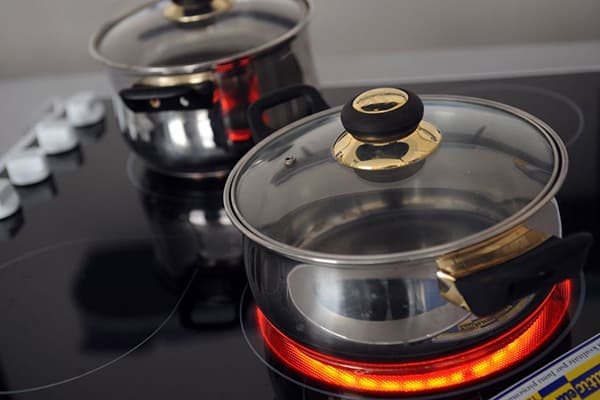

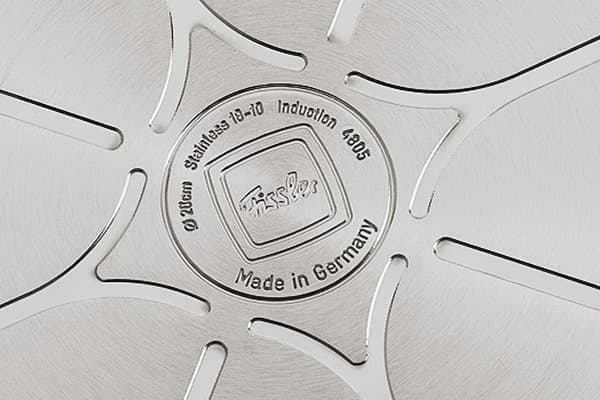
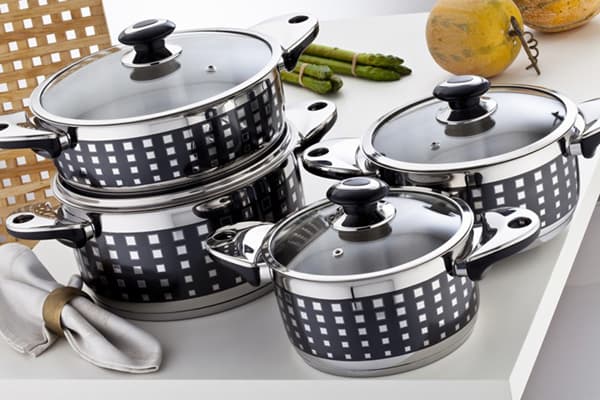
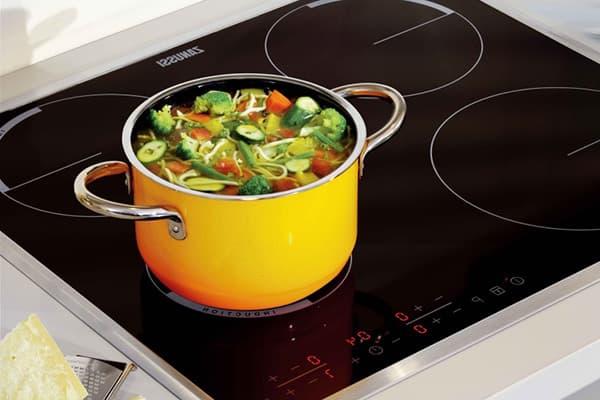
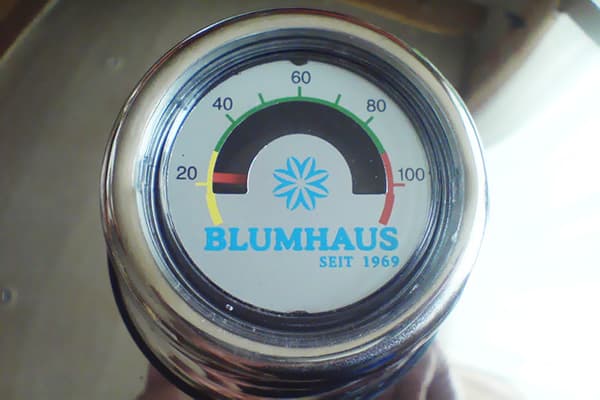
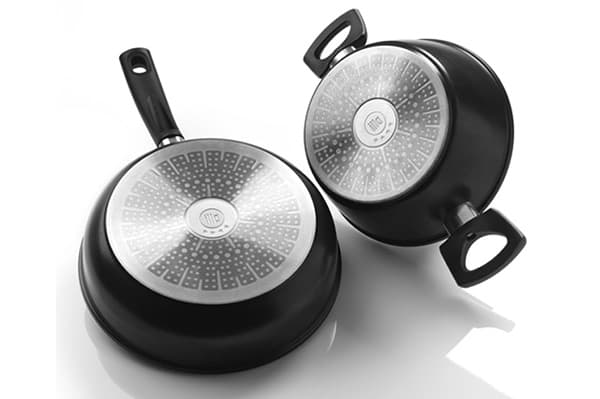
A pan with a copper bottom left marks on the stove. It's a shame I didn't read the article earlier.